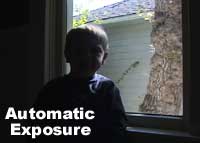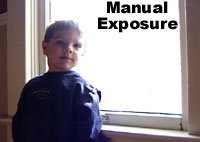|
Camera
Operation > Exposure
|

ABOVE:
Because the out-of-doors is much
brighter than the indoors, this shot
is messed up when you use automatic
exposure. The camera reads the bright
window and closes down the aperture
so very little light enters the camera
(sort of like how you squint on a
sunny day.)
BELOW: The only way to fix the shot
is to manually override the exposure
setting.

|
|
|
Did
you know that it is about 100 times brighter in your
back yard than it is in your living room? 100 times!
Don’t believe this? Try watching TV outside. It's
impossible! Your TV is only visible in the "dark"
environment of your home. Another example: turn on your
car headlights while you are driving at noon and see
what they illuminate. Nothing! Because they are overwhelmed
by the superbright sun.
Of
course, you don't notice these huge differences in brightness
because your eyes do an on-the-fly adjustment to compensate
for the variations. Camcorders can do on-the-fly brightness
adjustments too; it's just that they aren't as good
at it as the human eye. Not even close.
Your
camcorder has an "exposure" control
(also called "iris"or "f-stop")
which can be set to automatic or manual. The automatic
on-the-fly adjustment is fine for most scenes--and most
camcorder users never even learn to override automatic
and "go manual." But there are times when
you really do need to use the manual control.
A
typical example involves a shot of a person standing
in front of a window. In real life, your eye can take
in the brightness differences of the subject (fairly
dark) and the outside stuff you see through the window
(really bright). But even the most expensive camcorder
completely fails when it tries to shoot this scene.
Typically, the camcorder's automatic exposure control
is fooled by the bright window and thinks "Hey,
this is an outside scene; it’s really bright"
and then reduces the amount of light going into the
camera. The unfortunate result: it scales back the incoming
light so much, it can’t get a good picture of the
person, and so she is now seen in a silhouette.
The
solution to this common situation is to manually adjust
the exposure to let more light in. With some camcorders,
you can precisely adjust the exposure--cheaper camcorders
just have a button called "backlight." Either
way, increasing the amount of light entering the lens
means the camcorder will get a much better shot of the
subject--although everything in the window will now
be overexposed. So solution "B" is to get
away from the window.
More
on all this in the Lens Lesson later on in the course.

|